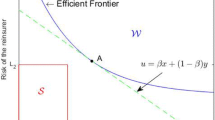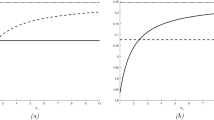Abstract
In this paper, the authors investigate the optimal per-claim reinsurance problem under the continuous-time framework to minimize the insurer’s ruin probability based on the Lundberg exponent. Considering reinsurance participants’ diversified risk preferences, the authors assume that the reinsurance premium is calculated by a combined premium principle, including the expected value premium principle and upper moment premium principle. Then, the authors derive the insurer’s optimal reinsurance strategy satisfying the principle of indemnity and the incentive compatibility condition in an infinite reinsurance space based on the point-wise optimization approach. Besides, the proposed work emphasizes the optimality and admissibility of the combination of the excess of loss reinsurance and its dual form when a piecewise reinsurance premium principle is considered. As a special case, the optimal reinsurance strategy under the expected value premium principle reduces to the classic result. Furthermore, the numerical analyses are provided to illustrate the effects of the main parameters on the maximal Lundberg exponent and the optimal reinsurance strategy.
Similar content being viewed by others
References
Asmussen S and Albrecher H, Ruin Probabilities, World Scientific, Singapore, 2010.
Schmidli H, Risk Theory, Springer, Cham, Switzerland, 2018.
Browne S, Optimal investment policies for a firm with a random risk process: Exponential utility and minimizing the probability of ruin, Mathematics of Operations Research, 1995, 20(4): 937–958.
Liang Z B and Guo J Y, Optimal proportional reinsurance and ruin probability, Stochastic Models, 2007, 23(2): 333–350.
Meng H and Zhang X, Optimal risk control for the excess of loss reinsurance policies, ASTIN Bulletin: The Journal of the IAA, 2010, 40(1): 179–197.
Hipp C and Taksar M, Optimal non-proportional reinsurance control, Insurance: Mathematics and Economics, 2010, 47(2): 246–254.
Li P, Zhou M, and Yin C C, Optimal reinsurance with both proportional and fixed costs, Statistics & Probability Letters, 2015, 106: 134–141.
Bi X C and Zhang S G, Minimizing the risk of absolute ruin under a diffusion approximation model with reinsurance and investment, Journal of Systems Science & Complexity, 2015, 28(1): 144–155.
Liang X Q and Young V R, Minimizing the probability of ruin: Two riskless assets with transaction costs and proportional reinsurance, Statistics & Probability Letters, 2018, 140: 167–175.
Centeno L, Measuring the effects of reinsurance by the adjustment coefficient, Insurance: Mathematics and Economics, 1986, 5(2): 169–182.
Liang X Q and Young V R, Minimizing the probability of ruin: Optimal per-loss reinsurance, Insurance: Mathematics and Economics, 2018, 82: 181–190.
Liang X Q, Liang Z B, and Young V R, Optimal reinsurance under the mean-variance premium principle to minimize the probability of ruin, Insurance: Mathematics and Economics, 2020, 92: 128–146.
Hald M and Schmidli H, On the maximisation of the adjustment coefficient under proportional reinsurance, ASTIN Bulletin: The Journal of the IAA, 2004, 34(1): 75–83.
Liang Z B and Guo J Y, Optimal investment and proportional reinsurance in the Sparre Andersen model, Journal of Systems Science & Complexity, 2012, 25(5): 926–941.
Meng H, Liao P, and Siu T K, Continuous-time optimal reinsurance strategy with nontrivial curved structures, Applied Mathematics and Computation, 2019, 363: 124585.
Kaluszka M, Optimal reinsurance under convex principles of premium calculation, Insurance: Mathematics and Economics, 2005, 36(3): 375–398.
Kaas R, Goovaerts M, Dhaene J, et al., Modern Actuarial Risk Theory: Using R, Springer Science & Business Media, New York, 2008.
Zhang L M and Li B, Optimal reinsurance under the α-maxmin mean-variance criterion, Insurance: Mathematics and Economics, 2021, 101: 225–239.
Bernard C, He X, Yan J A, et al., Optimal insurance design under rank-dependent expected utility, Mathematical Finance, 2015, 25(1): 154–186.
Xu Z Q, Zhou X Y, and Zhuang S C, Optimal insurance under rank-dependent utility and incentive compatibility, Mathematical Finance, 2019, 29(2): 659–692.
Meng H, Wei P Y, Zhang W L, et al., Optimal dynamic reinsurance under heterogeneous beliefs and CARA utility, SIAM Journal on Financial Mathematics, 2022, 13(3): 903–943.
Taksar M and Zeng X D, Optimal non-proportional reinsurance control and stochastic differential games, Insurance: Mathematics and Economics, 2011, 48(1): 64–71.
Grandell J, Aspects of Risk Theory, Springer-Verlag, New York, 1991.
Tan K S, Wei P Y, Wei W, et al., Optimal dynamic reinsurance policies under a generalized Denneberg’s absolute deviation principle, European Journal of Operational Research, 2020, 282(1): 345–362.
Meng H, Wei L, and Zhou M, Multiple per-claim reinsurance based on maximizing the Lundberg exponent, Insurance: Mathematics and Economics, 2023, 112: 33–47.
Author information
Authors and Affiliations
Corresponding author
Ethics declarations
The authors declare no conflict of interest.
Additional information
This research was supported by the National Natural Science Foundation of China under Grant Nos. 12071498 and 12371478, the Program for Innovation Research in Central University of Finance and Economics and Innovation Introduction Base for Insurance Risk Analysis and Decision Making Discipline under Grant No. B17050.
About this article
Cite this article
Wang, Y., Meng, H. & Liao, P. Optimal Reinsurance Strategy Based on the Lundberg Exponent. J Syst Sci Complex (2024). https://doi.org/10.1007/s11424-024-3199-8
Received:
Revised:
Published:
DOI: https://doi.org/10.1007/s11424-024-3199-8




